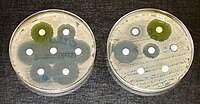
Photo from wikipedia
Purpose To shorten the turnaround time for blood culture (BC) analyses, a rapid method was developed for the direct identification, antimicrobial susceptibility testing (AST), and multidrug resistance testing of bacteria-positive… Click to show full abstract
Purpose To shorten the turnaround time for blood culture (BC) analyses, a rapid method was developed for the direct identification, antimicrobial susceptibility testing (AST), and multidrug resistance testing of bacteria-positive BCs. Materials and Methods The mixtures in BC bottles were treated with the multistep centrifugation method developed here and the conventional culture-based method. The bacterial sediment obtained after centrifugation was analyzed directly with MALDI-TOF MS and Vitek 2 Compact, and AST was performed directly with the Kirby–Bauer (K–B) disk diffusion, VITEK 2 Compact, and E-test methods. Extended spectrum lactamases (ESBLs) were detected with discs containing cefotaxime, cefotaxime/clavulanate, ceftazidime, and ceftazidime/clavulanate, and carbapenemase was detected with the modified carbapenem inactivation method (mCIM) and EDTA-mCIM (eCIM). Results All the results of direct testing were compared to those of the conventional methods, to evaluate the accuracy of the direct methods. The accuracies of the direct Vitek 2 Compact and MALDI-TOF MS methods were 95.5% (214/224) and 90.2% (202/224), respectively. Direct AST with K–B, Vitek 2, and E-test showed category agreement of 96.0% (2611/2721), 96.1% (2614/2721), and 97.4% (2650/2721), respectively, and the major errors and very major errors were < 2% for all three methods. In the direct determination of ESBLs, the results for cefotaxime combined with cefotaxime/clavulanate were completely consistent with those after the standard isolation method. The carbapenemase detection rate with direct mCIM and eCIM was exactly the same as that with the standard method. Conclusion These direct procedures based on multistep centrifugation are not only highly accurate but are appropriate for clinical laboratory use because the turnaround time is shorter.
Journal Title: Infection and Drug Resistance
Year Published: 2022
Link to full text (if available)
Share on Social Media: Sign Up to like & get
recommendations!